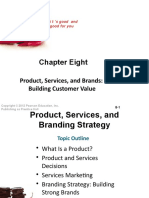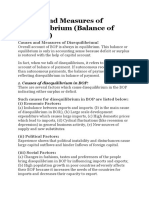Customer Value Proposition
Customer Value Proposition
Uploaded by
Sunita JeevatramCopyright:
Available Formats
Customer Value Proposition
Customer Value Proposition
Uploaded by
Sunita JeevatramCopyright
Available Formats
Share this document
Did you find this document useful?
Is this content inappropriate?
Copyright:
Available Formats
Customer Value Proposition
Customer Value Proposition
Uploaded by
Sunita JeevatramCopyright:
Available Formats
Customer value proposition
From Wikipedia, the free encyclopedia
Jump to: navigation, search This article's tone or style may not reflect the formal tone used on Wikipedia. Specific concerns may be found on the talk page. See Wikipedia's guide to writing better articles for suggestions. (November 2011)
Marketing
Key concepts
Product marketing
Pricing Distribution Service Retail
Brand management Account-based marketing
Ethics Research
Effectiveness Segmentation Strategy Activation Management Dominance
Marketing operations
Promotional contents
Advertising Branding
Underwriting spot Direct marketing Personal sales Product placement
Publicity
Sales promotion Sex in advertising Loyalty marketing Mobile marketing
Premiums Prizes
Promotional media
Printing Publication Broadcasting Internet Point of sale Merchandise
Out-of-home advertising
Digital marketing In-game advertising Product demonstration Word-of-mouth Brand ambassador Drip marketing Visual merchandising
v t e
See also: value proposition In marketing, a customer value proposition (CVP) consists of the sum total of benefits which a vendor promises a customer will receive in return for the customer's associated payment (or other value-transfer). Customer Value Management was started by Ray Kordupleski in the 1980's and discussed in his book, Mastering Customer Value Management.It was modified and expanded by Gautam
Mahajan to Total Customer Value Management[1]: is extended version of Customer Value embracing all aspects of business in creating value. A customer value proposition is a business or marketing statement that describes why a customer should buy a product or use a service. It is specifically targeted towards potential customers rather than other constituent groups such as employees, partners or suppliers. It is a clearly defined statement that is designed to convince customers that one particular product or service will add more value or better solve a problem than others in its competitive set.[2].
Contents
[hide]
1 Why CVPs are important 2 Creating a strong CVP 3 Competitive Advantage 4 Target Audiences 5 Types of CVP 6 Examples 7 See also 8 References 9 External links
[edit] Why CVPs are important
A good customer value proposition will provide convincing reasons why a customer should buy a product, and also differentiate your product from competitors. Gaining a customer's attention and approval will help build sales faster and more profitably, as well as work to increase market share.[3] Understanding customer needs is important because it helps promote the product. A brand is the perception of a product or service that is designed to stay in the minds of targeted consumers.
[edit] Creating a strong CVP
This section is written like a manual or guidebook. Please help rewrite this section from a descriptive, neutral point of view, and remove advice or instruction. (June 2010) In order to achieve objectives, a customer value proposition needs to be clear, concise and compelling. In order to develop a strong customer value proposition, organizations need to have a thorough knowledge of their potential/current customer base. By identifying customer needs through market research and analysis, firms develop clear and concise value propositions that reflect those needs and the tangible results that customers can reasonably expect from using the firm's products or services. Strong value propositions are also expressed from the customers
perspective and talk about the experiences and benefits that they will have when using the product.
[edit] Competitive Advantage
A product with a successful consumer value proposition is directly linked to a products actual and sustained performance versus competition. The two main attributes that allow consumers to differentiate among products are price and quality. Finding the correct balance between these two attributes usually leads to a successful product. If a company is able to produce the same quality product as its direct competition but sell it for less, this provides a price value to the consumer. Similarly, if a company is able to produce a superior quality product for the same or a slightly higher but acceptable price, the value to the consumer is added through the quality of the product. A product must offer value through price and/or quality in order to be successful.
[edit] Target Audiences
End user - The initial and ongoing satisfaction of the end user is the goal of every business. Customer satisfaction is achieved when superior customer value is delivered. Establishing a lasting business relationship will lead to future sales. Price and quality are the most important factors in a consumer purchase. Manufacturer/Distributor When the sales target is not the end user, but a manufacturer or distributor of a product, the most important factor is conveying superiority of one product over another. There may be other factors besides price and quality that would affect a customers decision and communicating those as well is essential[4].
[edit] Types of CVP
1. All Benefits - Most managers when asked to construct a customer value proposition, simply list all the benefits they believe that their offering might deliver to target customers. The more they can think of the better. This approach requires the least knowledge about customers and competitors and, thus, results in a weaker marketplace effort. 2. Favorable Points of Difference - The second type of value proposition explicitly recognizes that the customer has alternatives and focuses on how to differentiate one product or service from another. Knowing that an element of an offering is a point of difference relative to the next best alternative does not, however, convey the value of this difference to target customers. A product or service may have several points of difference, complicating the customer's understanding of which ones deliver the greatest value. Without a detailed understanding of customers requirements and preferences, and what it is worth to fulfill them, suppliers may stress points of difference that deliver relatively little value to the target customer. 3. Resonating Focus - The favorable points of difference value proposition is preferable to an all benefits proposition for companies crafting a customer value proposition. The resonating focus value proposition should be the gold standard. This approach
acknowledges that the managers who make purchase decisions have major, everincreasing levels of responsibility and often are pressed for time. They want to do business with suppliers that fully grasp critical issues in their business and deliver a customer value proposition thats simple yet powerfully captivating. Suppliers can provide a customer value proposition by making their offerings superior on the few attributes that are most important to target customers in demonstrating and documenting the value of this superior performance, and communicating it in a way that conveys a sophisticated understanding of the customers business priorities. Value Proposition All Benefits All benefits customers receive from a market offering Favorable Points of Difference All favorable points of difference a market offering has relative to the next best alternative Resonating Focus The key points of difference(and, perhaps, a point of parity) whose improvement will deliver the greatest value to the customer for the foreseeable future What is most worthwhile for our firm to keep in mind about your offering?
Consists of:
Answers the customer question:
Why should our firm Why should our purchase your offering firm purchase instead of your your offering? competitors? Knowledge of own market offering
Requires:
Knowledge of how own market Knowledge of own offering delivers superior value to market offering and next customers, compared with next best best alternative alternative Requires customer value research
Has the Benefit assertion Value Presumption potential pitfall
[5][6]
[edit] Examples
iPod vs. Other MP3 Players - As early as 1996 MP3 players were available to the public for purchase. For the first few years the only real value aside from price comparisons were the amount of music they could store. This all changed when Apple Inc. burst on the scene with the iPod and iTunes, the software paired with its new MP3 player to manage the music through a computer program to organize and rename the music on consumer computers. This software did not add cost to the iPod itself and was listed as a free add-on. This is a perfect example of a customer value added proposition. The customer is given added value through the software iTunes because it is free of additional cost to the customer. The combination of its intuitive and easy to use interface along with the customer value added proposition of iTunes, it is easy to see why the iPod in all of its forms dominated and still dominates the market. BMW vs. Other Luxury Car Manufacturers - BMW, "the ultimate driving machine". This is a key value proposition for BMW or Bavarian Motor Works. They build luxury
cars for those who can afford them. When other luxury companies started making vehicles in direct competition to BMWs, BMW had to differentiate itself once again. In North America it did this via a customer value added proposition through their No Cost Maintenance program. The No Cost Maintenance plan comes with the purchase of a new BMW vehicle and provides the owner with no cost maintenance for the first 4 years/50,000 miles of use. Neither Audi, Lexus nor Mercedes offer a comparable program.
Corvette ZR1 vs. Other Supercars - Chevrolet's Corvette ZR1 entered the market with great success, as a sports car with supercar performance, which shattered lap times of the fastest cars in the world around the Nurburgring. It established new records for quarter mile times. Its customer value added proposition is its price. The US market Corvette ZR1 price of $110,000 compared very favorably to the $150,000+ cost of cars it was outperforming. It is beating Ferrari, Porsche, Lamborghini, and Aston Martin in head to head competition for a significantly lower purchase price. This is an example of how Corvette offered value to the customer. Corvette used its reduced cost and superior performance as its value added proposition. Audi vs. Other Luxury Brands - Audi's introduction of the Quattro drive system in 1980 has led to it becoming almost synonymous with the use of all-wheel drive for highperformance vehicles. The Quattro all-wheel drive system sets Audi apart from major competitors in terms of perceived customer value added proposition, as although other luxury car manufacturers such as BMW, Mercedes and Jaguar also have all-wheel drive systems available, these are not as widely encountered and heavily marketed as Audi's. iPhone vs. Palm Pre - The Apple iPhone was introduced in 2007 and was almost immediately successful. As time passed the added value of the iPhone was equal and exceeded as other smart phones came to market. The Palm Pre was introduced with the ability to perform multiple tasks concurrently while the iPhone was only able to run a single application at a time. The multiapplication capability of the Palm Pre gave it a significant advantage over the iPhone. In 2010 Apple countered this with a new version of their operating system, iOS 4, which added multitasking. DLP vs Plasma TV - DLP TVs offer significant advantages versus plasma TVs. Specifically DLP tvs contain a bulb which illuminates the screen and is replaceable for approximately $250 (US). This allows for DLP tvs to have a longer lifespan and therefore is a more cost effective purchase than plasma for consumers.
You might also like
- Case #1 BMWDocument3 pagesCase #1 BMWAmir ShahNo ratings yet
- Organisational DevelopmentDocument63 pagesOrganisational DevelopmentSunita Jeevatram100% (2)
- Flaviano Mejia vs. Pedro Balolong: Government, and Not The City As An Entity. The Word 'Organize' Means 'To Prepare (TheDocument2 pagesFlaviano Mejia vs. Pedro Balolong: Government, and Not The City As An Entity. The Word 'Organize' Means 'To Prepare (TheShierii_ygNo ratings yet
- Jobs To Be Done Overview FinalDocument3 pagesJobs To Be Done Overview FinalDiego Alejandro Alvarez VillaNo ratings yet
- Crafting A Killer Value Proposition: Jaine Lucas Executive Director, IEI October 31, 2012Document35 pagesCrafting A Killer Value Proposition: Jaine Lucas Executive Director, IEI October 31, 2012SyedHash-HimNo ratings yet
- Value Proposition of StarbucksDocument3 pagesValue Proposition of Starbuckssuyash100% (2)
- Introduction To Business Model InnovationDocument49 pagesIntroduction To Business Model InnovationDuong Chi ThanhNo ratings yet
- Value Proposition Canvas PDFDocument5 pagesValue Proposition Canvas PDFArleni Alonso100% (6)
- Value-Proposition-by Griffith Business SchoolDocument20 pagesValue-Proposition-by Griffith Business SchoolAghni Anggi NggiNo ratings yet
- Blue Ocean StrategyDocument12 pagesBlue Ocean StrategySandeep MohanNo ratings yet
- Business Model Canvas (BMC)Document21 pagesBusiness Model Canvas (BMC)Eva FadillahNo ratings yet
- Operations ManagementDocument44 pagesOperations Managementnonu dhimanNo ratings yet
- Innovation Management Poster - A3-1Document1 pageInnovation Management Poster - A3-1Banoo AtiiisNo ratings yet
- Feasibility Analysis For Social Ventures: Beugré CDocument45 pagesFeasibility Analysis For Social Ventures: Beugré CBoyagNo ratings yet
- Market PositioningDocument17 pagesMarket PositioningJackie CasadoNo ratings yet
- 7 Measuring Social ImpactDocument24 pages7 Measuring Social ImpactHeningkan100% (1)
- POM LEC Ch1 Goods, Services & OMDocument26 pagesPOM LEC Ch1 Goods, Services & OMMatt VinceNo ratings yet
- Chapter 8 Product Services and Brands Building Customer ValueDocument43 pagesChapter 8 Product Services and Brands Building Customer Valueaal linconNo ratings yet
- UMJG 4042 Entrepreneurship Value Proposition & Business Canvas Plan Product Name: Smart WatchDocument3 pagesUMJG 4042 Entrepreneurship Value Proposition & Business Canvas Plan Product Name: Smart WatchNatasya KamarudinNo ratings yet
- Idea Generation+Innovation+FunnelDocument29 pagesIdea Generation+Innovation+Funnelrajaryan13No ratings yet
- Blue Ocean Strategy PresentationDocument27 pagesBlue Ocean Strategy PresentationOne Line ResourcesNo ratings yet
- The Business Model Canvas: Redhat Linux's Free Value PropositionDocument5 pagesThe Business Model Canvas: Redhat Linux's Free Value Propositionanpinom24No ratings yet
- Finding The Right Job For Your ProductDocument14 pagesFinding The Right Job For Your ProductHafiz Amanullah FarrukhNo ratings yet
- Assessing A New Venture's Financial Strength and ViabilityDocument32 pagesAssessing A New Venture's Financial Strength and Viabilitydedila nachar67% (3)
- Product DesignDocument12 pagesProduct DesignLalit MehndirattaNo ratings yet
- 6A BM Navigator SlidesDocument50 pages6A BM Navigator SlidesSHASHANK BHARATHI V ms22w040No ratings yet
- Value Proposition Design For The Circular Economy PDFDocument12 pagesValue Proposition Design For The Circular Economy PDFNúria Balogun OrtizNo ratings yet
- Folder Investor Pitch Deck-4Document25 pagesFolder Investor Pitch Deck-4Samuel CrombieNo ratings yet
- Value PropositionDocument55 pagesValue PropositionRose Ann Doctor-Espanol100% (1)
- TAM SAM SOM - What It Means and Why It MattersDocument2 pagesTAM SAM SOM - What It Means and Why It MattershksbrewerNo ratings yet
- Growth of Management Consulting Services in India PDFDocument14 pagesGrowth of Management Consulting Services in India PDFSugandha TanejaNo ratings yet
- Defining and Measuring Service QualityDocument34 pagesDefining and Measuring Service QualityKashyap Shivam0% (1)
- Developing A Social Venture Sustainability Model: Beugré CDocument31 pagesDeveloping A Social Venture Sustainability Model: Beugré CBoyag100% (1)
- Value Proposition CanvasDocument1 pageValue Proposition Canvasmina fendaNo ratings yet
- 1st 5Document118 pages1st 5M Fayez KhanNo ratings yet
- ABE Level 6 Business Ethics and Sustainability June 2018Document23 pagesABE Level 6 Business Ethics and Sustainability June 2018Immanuel Lashley100% (1)
- Disruptive InnovationDocument13 pagesDisruptive InnovationPriyadarshini DasNo ratings yet
- Business ModelsDocument88 pagesBusiness ModelsvamospudiendoNo ratings yet
- New ProductDocument14 pagesNew ProductEmon Ishtiak100% (1)
- The VRIO FrameworkDocument16 pagesThe VRIO FrameworkNila Masalikul MasrurohNo ratings yet
- Tender Pricing StrategyDocument35 pagesTender Pricing StrategyWan Hakim Wan Yaacob0% (1)
- Chapter 4 Designing Your SolutionDocument22 pagesChapter 4 Designing Your SolutionRamona Isabel UrsaisNo ratings yet
- Recognizing Opportunities and Generating Ideas: Sidra Nasreem Lecturer University of Central PunjabDocument37 pagesRecognizing Opportunities and Generating Ideas: Sidra Nasreem Lecturer University of Central Punjabnida younasNo ratings yet
- Lean CanvasDocument3 pagesLean Canvasapi-510224276No ratings yet
- Disruptive Innovation: Dr. Suresh ManimalaDocument33 pagesDisruptive Innovation: Dr. Suresh ManimalaVARARUCHINo ratings yet
- PEST-SWOT-Porter's 5 Forces Theory (2011)Document12 pagesPEST-SWOT-Porter's 5 Forces Theory (2011)Akbar Hossain100% (2)
- The Business Model Canvas - EntrepreneurshipDocument24 pagesThe Business Model Canvas - EntrepreneurshipYoung SmartNo ratings yet
- Social Entrepreneurship - Business ModelsDocument12 pagesSocial Entrepreneurship - Business ModelsShinu AbhiNo ratings yet
- Parcon Consulting, LLC: Understanding Value PropositionsDocument18 pagesParcon Consulting, LLC: Understanding Value PropositionsMapycha100% (1)
- Value Proposition Canvas Template and Guide hd9tp7 PDFDocument20 pagesValue Proposition Canvas Template and Guide hd9tp7 PDFBandita ParidaNo ratings yet
- Lean Business ModelDocument9 pagesLean Business ModelDivyanshuNo ratings yet
- C2 - Creating and Capturing ValueDocument29 pagesC2 - Creating and Capturing ValueDenis ManoleNo ratings yet
- Value Proposition Canvas: Product CustomerDocument2 pagesValue Proposition Canvas: Product CustomersirineNo ratings yet
- Concept Testing: Prof M R SureshDocument16 pagesConcept Testing: Prof M R SureshAastha VyasNo ratings yet
- Business Model Canvas WorkshopDocument82 pagesBusiness Model Canvas WorkshopAlex Cowan98% (96)
- pp08Document15 pagespp08kansanNo ratings yet
- Business Model Innovation - Deloitte ConsultingDocument28 pagesBusiness Model Innovation - Deloitte Consultingamine.luuckNo ratings yet
- Customer Value PropositionDocument4 pagesCustomer Value PropositionShashank Gupta100% (1)
- Assignment 1 - Group 9Document9 pagesAssignment 1 - Group 9Kartik SinghNo ratings yet
- B2B Assignment 1Document5 pagesB2B Assignment 1Abhishek100% (1)
- Value PropositionDocument5 pagesValue PropositionJohn Frix Alejano100% (1)
- KJLKJLKDocument29 pagesKJLKJLKggyutuygjNo ratings yet
- Training & DevelopmentDocument41 pagesTraining & DevelopmentSunita JeevatramNo ratings yet
- Wp1310 LibreDocument38 pagesWp1310 LibreSunita JeevatramNo ratings yet
- Theoriesofentrepreneurship 130409045555 Phpapp01Document7 pagesTheoriesofentrepreneurship 130409045555 Phpapp01Sunita JeevatramNo ratings yet
- EMBA Thornhill 4bDocument29 pagesEMBA Thornhill 4bSunita JeevatramNo ratings yet
- Marketing S2Document12 pagesMarketing S2Sunita JeevatramNo ratings yet
- Meaning of Labor Unrest: Labor Unrest Is A Term Used by Employers or Those Generally in The BusinessDocument1 pageMeaning of Labor Unrest: Labor Unrest Is A Term Used by Employers or Those Generally in The BusinessSunita JeevatramNo ratings yet
- Research MethodologyDocument39 pagesResearch MethodologySunita JeevatramNo ratings yet
- Aspirational Reference GroupDocument1 pageAspirational Reference GroupSunita JeevatramNo ratings yet
- Business Consolidation (SEM-BCS) PDFDocument180 pagesBusiness Consolidation (SEM-BCS) PDFparivijjiNo ratings yet
- Assignment No 1: Areeb ShahidDocument7 pagesAssignment No 1: Areeb ShahidareebNo ratings yet
- Assessment Task 1 BSBHRM506Document13 pagesAssessment Task 1 BSBHRM506kanika33% (6)
- Snow Itsm OvervDocument5 pagesSnow Itsm OvervmanedeepNo ratings yet
- Business Ethics and EtiquetteDocument15 pagesBusiness Ethics and EtiquetteLya Hellen100% (1)
- Construction Technology & Management 7th Sem.Document12 pagesConstruction Technology & Management 7th Sem.sanjay kumarNo ratings yet
- Residual Risk Level Step & Activities Hazard, Env. Aspect Risk, Env. Impacts Resiko DanDocument1 pageResidual Risk Level Step & Activities Hazard, Env. Aspect Risk, Env. Impacts Resiko DanIwan RayaNo ratings yet
- Ike Retail - Inventory Stock ControlDocument7 pagesIke Retail - Inventory Stock ControlframestiNo ratings yet
- Complete Guide To Ethics Management: An Ethics Toolkit For ManagersDocument30 pagesComplete Guide To Ethics Management: An Ethics Toolkit For ManagersMary PosterNo ratings yet
- DisequillibriumDocument6 pagesDisequillibriumMonika PathakNo ratings yet
- Build Operate Transfer (BOT)Document25 pagesBuild Operate Transfer (BOT)Jim Juan OsmanNo ratings yet
- Bookkeeping Final SolutionDocument25 pagesBookkeeping Final SolutioncreeprhuelNo ratings yet
- Grand Design 2021Document25 pagesGrand Design 2021Anza ZahyaNo ratings yet
- Topic 7 - Power of AttorneyDocument50 pagesTopic 7 - Power of AttorneyAqilah Zainal100% (1)
- AMLADocument2 pagesAMLAheymissrubyNo ratings yet
- Introduction To Service Operations ManagementDocument42 pagesIntroduction To Service Operations ManagementAmit ChauhanNo ratings yet
- PT&T V CADocument2 pagesPT&T V CAeieipayadNo ratings yet
- Investment Appraisal TechniquesDocument14 pagesInvestment Appraisal TechniquesIan MutukuNo ratings yet
- GST CertificateDocument3 pagesGST CertificatePATEL SAHILKUMARNo ratings yet
- Consolidated Bostick 13APR2015 Plaintiff MotionsDocument267 pagesConsolidated Bostick 13APR2015 Plaintiff Motionstheskeptic21No ratings yet
- Patanjali Case Study 3Document8 pagesPatanjali Case Study 3Tanay saha100% (1)
- Demand E0f0c50b Ead9 4dcb 9b73 60b0dfbbfda1Document24 pagesDemand E0f0c50b Ead9 4dcb 9b73 60b0dfbbfda1Ujjwal KumarNo ratings yet
- Bid Document Bid Details: Air Conditioner (2 Pieces)Document3 pagesBid Document Bid Details: Air Conditioner (2 Pieces)Madheshwer Yadav100% (1)
- Far Eye OMS Integration and WorkingDocument2 pagesFar Eye OMS Integration and WorkingPadmanabh badoniNo ratings yet
- Practice Set 1 (Cost Segregation)Document3 pagesPractice Set 1 (Cost Segregation)Ridskiee VivanggNo ratings yet
- Strategic Competitice AnalysisDocument30 pagesStrategic Competitice AnalysisNgang PerezNo ratings yet
- Uganda Advanced Certificate of Education S.6 Entrepreneurship Education Paper 1 Time: 3hours InstructionsDocument2 pagesUganda Advanced Certificate of Education S.6 Entrepreneurship Education Paper 1 Time: 3hours Instructionsneleon melodieNo ratings yet
- QC Test Multiple ChoiceDocument7 pagesQC Test Multiple Choiceneeru.satya20056476No ratings yet
- Andrada, Et. Al. v. NLRCDocument4 pagesAndrada, Et. Al. v. NLRCacolumnofsmokeNo ratings yet


































































































